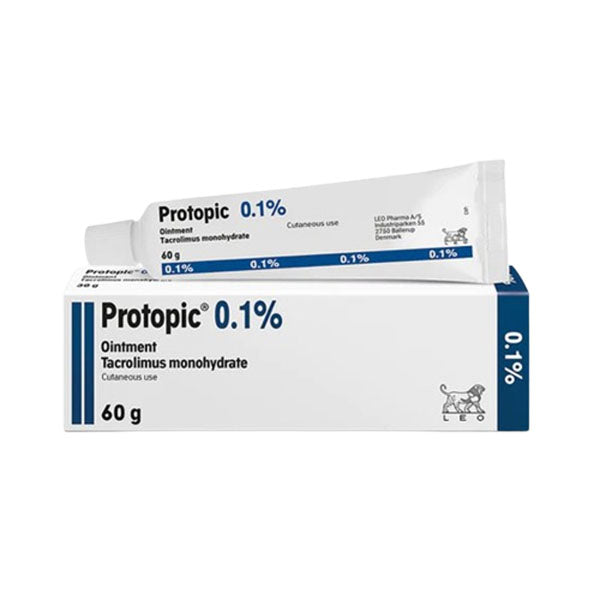Protopic 0.1% ointment 60 gm:
Tacrolimus monohydrate 0.1% ointment.
What are the uses of tacrolimus ointment?
- Tacrolimus monohydrate is an immunomodulatory agent.
- Tacrolimus ointment is used to treat moderate to severe atopic dermatitis in adults who do not respond adequately to or do not tolerate conventional treatments such as topical corticosteroids and in children (ages 2 years and older) who have failed to respond adequately to conventional treatments such as topical corticosteroids.
- Once moderate to severe atopic dermatitis has cleared or almost gone after up to 6 weeks of flare treatment, and if you have frequent flare-ups (i.e. 4 or more per year), it may be possible to prevent flares again or prolong Time you are flare-free by using tacrolimus ointment twice weekly.
- In atopic dermatitis, an overreaction of the skin's immune system leads to skin inflammation (itching, redness, and dryness).
- Tacrolimus alters the abnormal immune response and relieves skin inflammation and itching.
Do not use tacrolimus ointment:
- If you are allergic to tacrolimus, any of the other ingredients of this medication, or to macrolide antibiotics
Warnings and precautions:
Talk to your doctor before using tacrolimus ointment:
- If you suffer from liver failure.
- If you suffer from skin diseases.
- If you have any malignant skin tumors.
- If you have a weak immune system.
- If you have swollen lymph nodes when you start treatment.
Possible side effects:
Like all medicines, this medicine can cause side effects, although not everybody gets them. These side effects include:
- Burning and itching.
- redness.
- Feeling warm.
- pain.
- Increased skin sensitivity (especially to heat and cold).
- Skin tingling.
- rash.
- Local skin infection regardless of specific cause including but not limited to: inflamed or
- Infected hair follicles, cold sores, generalized herpes simplex infections.
- Facial redness or skin irritation after drinking alcohol is also common.
- young love.
- Injuries at the twice-weekly application site have been reported in children and adults. Impetigo, a superficial bacterial skin infection that typically produces blisters or ulcers on the skin, has been reported in children.
- Rosacea (redness of the face), rosacea-like dermatitis, lentigo (the presence of flat brown spots on the skin), edema at the application site, and eye herpes infection have been reported during post-marketing experience.
Other medicines and tacrolimus ointment:
- Tell your doctor or pharmacist if you are using, have recently used or might use any other medicines.
- You can use moisturizing creams and lotions during treatment with tacrolimus ointment but these products should not be used within 2 hours of applying tacrolimus ointment.
- The use of tacrolimus ointment at the same time as other preparations on the skin or while taking oral corticosteroids (such as cortisone) or medications that affect the immune system has not been studied.
Instructions for use:
- Always use this medication exactly as your doctor has told you to. Consult your doctor or pharmacist if you are not sure.
- Apply tacrolimus ointment as a thin layer to the affected areas of your skin.
- Tacrolimus ointment can be used on most parts of your body, including your face, neck, and in the creases of your elbows and knees.
- Avoid using the ointment inside your nose, mouth, or in your eyes. If the ointment comes into contact with any of these areas, it should be wiped off completely and/or rinsed with water.
- Do not cover treated skin with bandages or wraps.
- Wash your hands after applying tacrolimus ointment unless your hands have also been treated.
- Before applying tacrolimus ointment after showering, make sure your skin is completely dry.
Adults (16 years and over):
- Two strengths of tacrolimus ointment (Tacrolimus Ointment 0.03% and Tacrolimus Ointment 0.1%) are available for adult patients (16 years and older). Your doctor will decide which strength is best for you.
- Usually, treatment begins with tacrolimus 0.1% ointment twice a day, once in the morning and once in the evening, until the eczema disappears. Depending on the response of your eczema, your doctor will decide whether the frequency of application can be reduced or tacrolimus 0.03% ointment can be used.
- Treat each affected area of your skin until the eczema goes away. Improvement usually appears within one week. If you do not notice any improvement after two weeks, consult your doctor about other possible treatments.
- Your doctor may tell you to use tacrolimus ointment twice weekly once your atopic dermatitis has cleared or almost gone (tacrolimus 0.03% ointment for children and tacrolimus 0.1% ointment for adults). Tacrolimus ointment should be applied once a day twice a week (eg Monday and Thursday) to areas of the body usually affected by atopic dermatitis. There should be 2-3 days without tacrolimus ointment treatment between applications.


